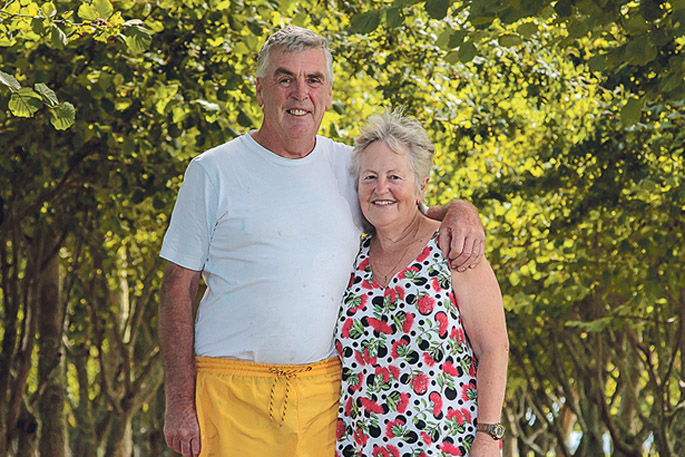Maureen and Colin Binns have turned a small lifestyle block in the Bay of Plenty into a truffière. Relocating from Wellington nearly 15 years ago, they initially lived in Maketu, before discovering a piece of land tucked away near Paengaroa.
Paddocks, an orchard, a lookout and an old airplane runway stand above 10 acres of native bush including rewarewa, with the 10 acres protected by a QE11 covenant. Below, the Mangorewa River flows northeast towards the Kaituna River.
Absolutely amazing
The idea of growing truffles came about because the previous owner was interested in them.
“We didn’t plan to put truffles in when we bought the land,” says Colin. “The previous owner had left some pamphlets.”
“We wondered why, so we did some research,” says Maureen. “When Colin’s brother and sister-in-law came out from England, we went down south for a tour and stayed at one of the truffle grower’s places. “It snowed. It was absolutely amazing, and we got more interested.”
In 2008, Colin ploughed 50 tonne of lime into a half-hectare paddock, helping pitch the right pH. Perigord black truffles require high soil pH – a minimum 7.8 – whereas bianchetto fruit at lower soil pH, between 6.5 and 7.3.
Once the soil was prepared, they planted the trees – half of them oak and the rest hazelnut.
“We had ordered several thousand dollars of little tiny sticks,” says Colin. “We had a couple of Dutch Woofers, who measured out the distances between where the sticks needed to be planted.
“We had a good success rate and only lost about 15. We didn’t know at first why they died, but one day I was down there with a torch and saw little black beetles. They were ringbarking the tree just under the surface.”
This is now their fourth harvest – and Colin says growing truffles is a fascinating science.
No regime
“It takes an awful long time to get a crop – it’s a bit like playing Lotto,” says Colin. “The trees grow truffles if they want to.
“They’re not like kiwifruit or avocados, which have a spraying and pruning regime. With truffles, there’s absolutely no regime apart from staying out of the truffière.”
“Every year when my oldest grandson would come up from Wellington, he’d measure himself against one of the oaks,” says Maureen. “He was always taller than it, but now it’s quite big. And he’s eight.”
They tread softly through the centre of the truffière in their Crocs, which they say help spread their weight evenly.
The truffle fungus explores the soil for water and mineral nutrients, which it passes along to the tree. In exchange, the tree provides sugars produced through photosynthesis to the fungus. This interdependence between the tree and the fungus is subtle and fragile.
Colin put pumice over some of the truffles that rose above the surface of the ground.
“We’re hoping the pumice will protect them from sunburn, slugs and snails,” says Colin. “You really want them to grow underground. We go twice a week and look for changes in the ground. When they’re ripe the dog can smell them.”
The advantage of having ‘Jed’ the English springer spaniel, rather than a truffle pig, is that he’s not interested in eating the truffles once he’s found them. Colin enjoys the word association of the dog’s name with Jed Clampett, The Hillbillies, Texas tea – black gold.
They’ve also put in olive trees, run sheep in other paddocks, and developed an orchard. Growing there are grapes, passionfruit, macadamia nuts, almonds, persimmons, limes, mandarins, cherries, nashis, pears, grapefruit, peach, walnuts, plums, and apples. Ducks and hens provide eggs, and nearby is a vegetable garden
Truffle tour
This year the couple is to visit truffle farms in Croatia, Italy and Eastern France.
“When we go to Lyon, we’ll visit a French truffière where they produce the black Perigord truffles,” says Maureen. “We’ll do a day trip to do a truffle tour, truffle dinner, and meet people growing truffles in Croatia. I’d like to be able to host truffle farmers, invite them to come and stay on a truffière in NZ.”
The couple have converted their sleepout into bed and breakfast accommodation for overseas truffle farmers.
“There are a lot of truffle growers in the Bay of Plenty,” says Colin. “And we belong to the NZ Truffle Growers Association. There are about 300 members in NZ.”
It’s now 10 years since Colin and Maureen planted the trees in 2008, and they’ve had three harvests since. “We harvest enough for us to have personally and to share with friends. We’re hoping for an increasing harvest.
“Each year we’ve got more and more truffles. But the guy who sold us the trees has been producing for about 20 years. He says some years he gets nothing, whereas some years are good years.”



0 Comments
Leave a Comment